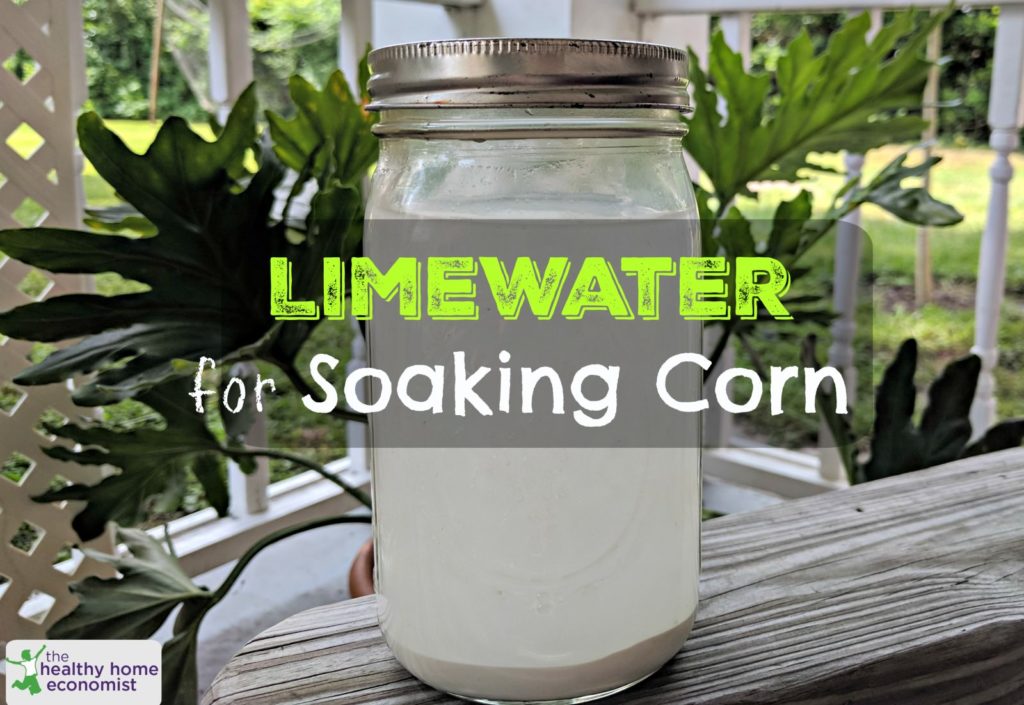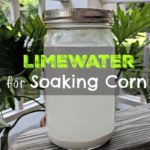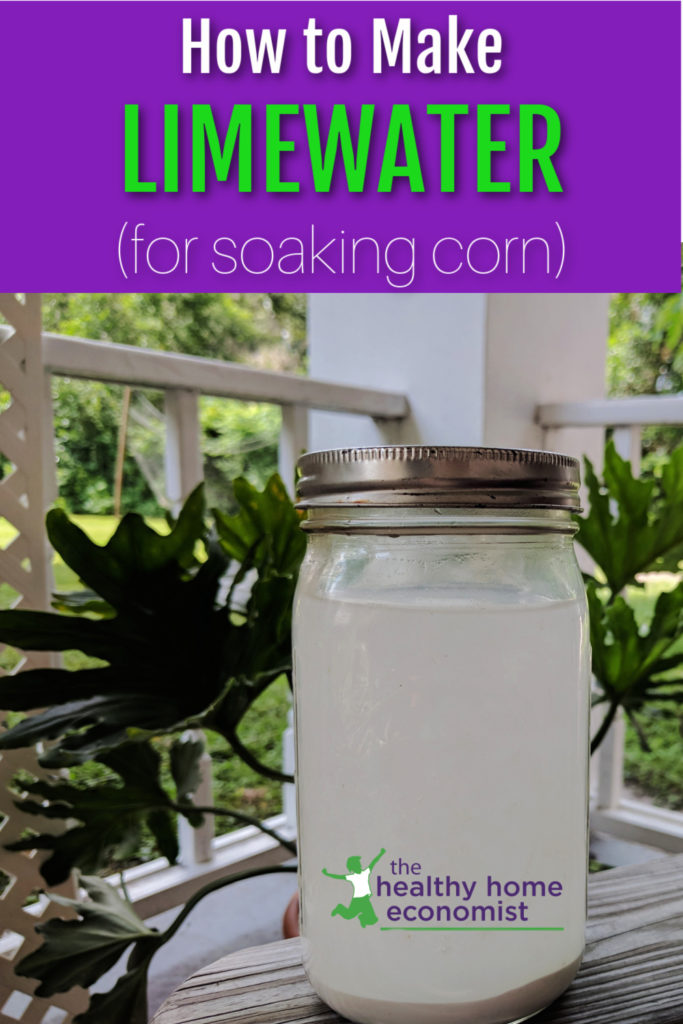Table of Contents[Hide][Show]
How to make limewater for soaking corn in accordance with traditional Native American cultures for improved digestibility and bioavailability of nutrients.

Corn has a bad rap these days primarily due to the pervasive presence of high fructose corn syrup (HFCS) in the food supply. This frankenfood is generally made with GMO corn and laced with mercury residue from processing. (1)
It is in the majority of processed foods and drinks and is being blamed for all sorts of health woes including a role in the obesity epidemic.
The truth is, however, that corn is a traditional food! When high quality, nonGMO corn is sourced and prepared properly using limewater, it can be both delicious and healthy!
And, if you are a Southern gal like me, you like your corn – am I right?
Grits and homemade cornbread anyone?
Why Soak Corn?
Soaking corn or cornmeal overnight in limewater releases Vitamin B3. It also improves the amino acid profile of the corn making for easier digestion.
Note, you do not have to soak cornstarch. The reason is that the nutritional value of cornstarch is very low as it is basically just pure carbohydrate.
If whole food forms of corn are a staple in your diet, then soaking in limewater is a must. The disease pellagra is caused by Vitamin B3 deficiency. Symptoms of pellagra include sore skin, mental problems, and fatigue. Most doctors fail to ever diagnose it!
Even if you don’t eat corn that frequently, limewater is easy to make and lasts for a long time in the refrigerator or cool pantry. Why not soak your corn to create homemade corn dishes? It is an easy to do step that improves the nutrition and digestibility of the meal.
In the video included with the recipe below, I show you how to make limewater using the Nourishing Traditions method. It is the proper soaking medium for corn in North and South American traditional societies. The healthy, strong, and fierce Seminole Tribe of Florida, for example, sustained themselves primarily on soaked corn gruel.
Masa Harina?
Note that preparing masa harina is slightly different. This type of corn flour has already been treated with lime. Thus, limewater is not needed, however, it will still require soaking in a slightly acidic medium like buttermilk or water with a squeeze of lemon juice. This serves to deactivate anti-nutrients like phytic acid.

Homemade Limewater Recipe
How to make limewater using the traditional method that will create more nutritious and digestible corn based dishes for your family. Can also be sipped as a beverage for extra calcium!
Ingredients
- 4 Tbl dolomite powder
- filtered water
- 1 quart mason jar
Instructions
-
Spoon dolomite powder into a 1 quart mason jar. It should be spread evenly about 1/2 inch deep at the bottom of the jar.
-
Fill the mason jar with filtered water. Leave about 1 inch at the top.
-
Screw on the lid tightly and turn a few times to mix the dolomite powder in the water.
-
Leave the jar on the counter until the dolomite fully settles out at the bottom of the jar. This will take a few hours, and then the water will be clear.
-
Place the jar in the refrigerator or cool pantry. Use this water for soaking corn and corn flour for any corn based dishes.
Recipe Video
Recipe Notes
Use 1 cup of limewater for every 2 cups of corn or cornmeal for making cornbread, corn casserole and other corn based dishes.
Pour the limewater out of the mason jar carefully - you don't want to use the lime that has settled at the bottom, only the limewater. Soaking for 12-24 hours is sufficient to release the nutrients but cornbread in particular will rise better if soaked for 24 hours.

Recipes using Soaked Corn
With your limewater ready to go, here are a few recipes to try that require the soaking of corn flour and meal.








Is the corn cooked in the limewater? Any useful purpose for the limewater after the corn has been drained? Or does the corn absorb all of it?
Hello Sarah,
I wanted to clarify some things for your readers regarding this post on soaking corn in lime water. This topic is very near and dear to my heart, as I have been completely geeking out about growing heirloom corn, nixtamalizing corn (the process of steeping it in lime), and making the “perfect” tortilla for some time now.
There are many different forms of “lime” which has caused quite some confusion! Lime actually undergoes a chemical cycle, during which it takes on three different forms: calcium carbonate, calcium oxide, and calcium hydroxide. The raw material of lime is calcium carbonate, either in the form of limestone, sea shells, chalk, marble, or coral. When burned at high temperature, these naturally occurring materials form calcium oxide, or quicklime. The quicklime can then be “slaked” by adding it to water, resulting in a heat releasing reaction that forms calcium hydroxide.
When nixtamalizing corn with “lime”, you need CALCIUM HYDROXIDE, or CALCIUM OXIDE, which, as I just explained dissolves into calcium hydroxide when added to water. Calcium hydroxide is an alkaline solution, meaning it is basic and caustic. It has special chemical properties that make it capable of dissolving the hard outer layer of the corn kernel, allowing the seed to swell, and releasing bound nutrients. Dolomite powder, as you recommend, is really just ground up high magnesium limestone. Both dolomite powder and calcium carbonate powder are sold as dietary supplements and agricultural amendments. This ground rock, however, is insoluble in water, rendering it inert for the purpose of nixtamalizing corn. If you buy lime for nixtamalization at the store, you’ll need to look for “cal” or “pickling lime”, as some of your readers commented. Both are food grade white powders. Cal (found most easily in mexican grocery stores) is quicklime, while pickling lime (used in the pickling process to ensure crispness) is calcium hydroxide. I have never come across an account of traditional cultures soaking their corn in dolomite powder, and as far as I know, it will do little more than adding a little calcium to your diet.
As nixtamalization was employed in a vast expanse of corn-centered societies, there is substantial variation in historic accounts of how the process was conducted. However, all of them involve steeping whole field corn in an alkaline solution (lime water or wood ash lye), and then thoroughly rinsing the kernels clean. This corn is now called hominy or nixtamal, and can be WET ground- coursely into grits, or finely into masa flour for tortillas, tamales, etc. Of course you can dry it for storage too.
Another note on corn, which I think might be of interest/concern to your reader population: the cornmeal you buy at the store is actually stripped of its outer nutrient containing layers, as well as its germ-the portion of the seed which contains the oils that can go rancid with prolonged storage. Cornmeal from the store is really just ground endosperm (the starch portion of the seed), and has significantly diminished nutritional quality and flavor–and of course, doesn’t easily go bad because of this. Buying your own corn and grinding it is a good idea, as you recommend, although the corn you buy from the store is still likely to be contaminated by GMOs. Corn is wind pollinated, and can therefore easily cross with each other within a radius of up to 2 miles. Technically, the “Organic” label on corn means it is not a genetically modified variety, but this does not account for the potential, and likely, contamination (an average of estimates I’ve see is about 5% of all “Organic” corn is contaminated). I’m still on the search for a good source of non-gmo contaminated heirloom corn…but in the meantime, i’ll just keep trying to grow what I can!
I have a full description of types of corn and alkali used, and an step-by-step outline of the process, for anyone interested, confused, or curious : http://homescale.wordpress.com/corntortillas/ It also clarifies the questions surrounding “corn on the cob” vs. popcorn vs. corn used as a cereal grain.
Hoping this information is helpful to you and your readers. I know I love my traditionally prepared corn, and am always enthusiastic to share the wonders of this ancient food technology with others.
tonia
I can’t access your article unless I register for wordpress account, then I have to find your article. Is it anyway to access your article without having to register.
Hi there would love to read your article however it’s private. Also in regards to organic corn it’s my understanding it has to be at least 5 miles from any Gmo corn and batch tested free if gmos to be labeled organic. The gmo corn is patent protected and they will sue if contaminated from what I’ve heard and they apparently love to do so
Tonia, I am seriously late in reading this post but I’m wondering if I follow your method to soak cornmeal I received from a non-gmo farmer, would I need to rinse it afterwards?
Sarah, it was asked several times and i never saw an answer. Could you tell me, do you rinse the cornmeal after it has soaked in the lime water? Or do you just use it with the lime water in it?
Thank you. Love your videos and would love to see you make cornbread!
Joie
Do you use your Champion grinder to grind your corn into flour, or a specialty grinder? I have a Champion, too, but I’ve never done corn.
I thought in Mexico they did use limes.
PS/Maybe you could share your recipe with us!
Could you elaborate just a little further as to using the soaked cornmeal in a recipe? I would assume the soaked cornmeal is like pudding the next day. How does that affect ( if at all) the amount of liquid you would normally add while making a cornbread recipe? Should one only soak exactly the amount of cornmeal called for in their recipe and adjust the limewater ratio accordingly ? ( I should think soaked cornmeal would be too difficult to measure out afterwards).
soak cornmeal and grits, but what about regular corn off the cob? I have a wheat grinder, do you just throw your corn in that to make the cornmeal, can you make your own grits?
I’m wondering how a cornbread recipe will need to be altered if I use soaked cornmeal? I’m assuming that because the corn is moist that the proportions of ingredients will change-is this correct?